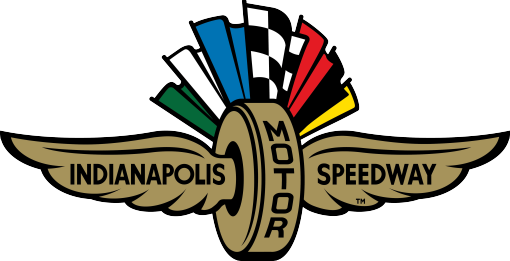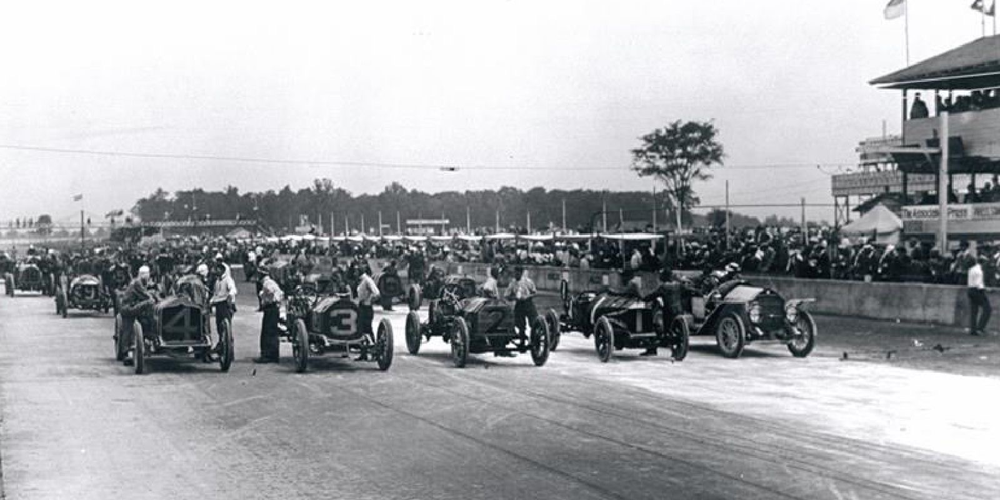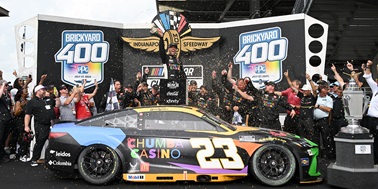One of the great iconic images of the Indianapolis Motor Speedway’s earliest days depicts a man crouching over a model of the track at the construction site of the great Speedway in 1909. Frequently misidentified as Speedway President Carl Fisher, the photo is actually of Lewis Putnam Strang, one of the great drivers of the day.
Strang was born in 1884 with all the advantages as the eldest son of a prominent Amsterdam, New York family. Educated in private schools, he was a direct descendent of Revolutionary War General Israel Putnam, best known for urging his troops at Bunker Hill, “Don’t fire until you see the whites of their eyes!” Then, with brutal suddenness, he lost both his parents to illness, leaving him a teenager with three young sisters to support.
In 1902, 18 year-old Lewis became a chauffeur for Herbert Franklin, and he eventually was connected with German driver Emil Stricker, who mentored him in the art of road racing.
The “Go To” Man
He earned a solid reputation as the “go to” man to demonstrate cars from 1903 through 1905. Strang was called upon by Dale & Co., the American agents for the French Berliet cars as well as Joseph Heller, an importer of Belgium’s Pipe automobile brand. With Heller in 1905 he got his first crack at real racing, gunning the Pipe down a mile straightaway at a race in Long Branch, N.J.
On October 6, 1906, Strang appeared at the Vanderbilt Cup with his uncle, J. Walter Christie, who built his own cars and pioneered front wheel drive before later designing tanks and other military equipment. Strang was Christie’s riding mechanic, and while they finished 13th in a field of 17, Lewis Strang had a taste of big time racing.
His uncle played a huge role in his career in 1907. They traveled to France as the only American entry in the July 2nd French Grand Prix, at that time the biggest race in the world. Tire failure, a sticky engine valve and clutch problems pushed them to the bottom of a field of 38 cars.
Returning to America, Strang drove for the American agents of the French Delahaye and Pilain automobiles, most notably finishing a 24 hour contest sixth in a field of 14 at Brighton Beach, New Jersey in October. Strang captured national attention with a new track record of 67.16 MPH when he drove the Christie Grand Prix car on October 16 at the Birmingham, Alabama state fairgrounds dirt mile.
Unquestionably, 1908 was Lewis Strang’s breakout year. Driving a crimson Isotta-Fraschini imported from Milan, Italy by his 22 year-old buddy John H. Tyson, Strang proved unbeatable. He dominated the major road races on the public roads of Savannah, Georgia; Briarcilff, New York and Lowell, Massachusetts. His dominance was apparent – he led all but one of the cumulative laps of the three races.
Said Strang after the Briarcliff race, “…a driver should never hold back, for a race starts right from the word ‘go’…no race has been won from laying back unless the other cars break down, and then it’s only a gamble.”
Evidence of the respect Strang commanded is that just prior to the Lowell road race he was recruited by the E.R. Thomas Motor Company in a bid to win the French Grand Prix – widely regarded as the premier auto race in the world at the time.
While there could be little doubt of Strang’s talent, his mount was not up to the task. A faulty clutch ended his day on just the fourth of 10 laps, putting him well down in the field.
On Top of the World
Back in America, Lewis Strang must have felt he was on top of the world by September 7, 1908. That was the day the 24 year-old nailed down his third major stock car road race win of the year in the 254.4 mile Congressman Butler Ames Trophy at Lowell, Massachusetts. He was engaged and soon to be married to Hartford, Kentucky’s Jeanne Lou Spalding, an actress who took the stage name, “Louise Alexander.”
All this success attracted the attention of Paul LaCroix, the owner of a Renault racing team. LaCroix offered Strang the opportunity to drive the Renault Grand Prix racer in the Vanderbilt Cup, immediately installing Strang as the favorite to win America’s most important race.
The October 24 Vanderbilt Cup proved to be a big disappointment for Strang. A faulty magneto delayed his start and the Renault eventually failed with a defective clutch before completing four laps.
Just three weeks after marrying Jeanne Spalding, Strang teamed with his old mentor, Emil Stricker, on November 17 in a 24 hour record attempt at Birmingham, Alabama. Strang had just handed his Renault over to Stricker when shortly after midnight two tires exploded and sent the car into the fence. Stricker was killed instantly. This introduction to the dark side of racing terrified his new wife.
Strang conjured up the courage to bring the Grand Prix Renault home in sixth place just nine days later at the first American Grand Prize at Savannah. He was the highest placed American driver among an outstanding field of European road racers.
Buick called on Strang to join Bob Burman and Louis Chevrolet on their racing team for 1909 and he quickly rewarded them with a first and second in two 100 mile races March 23 and 24. He followed that up on March 27 with two class wins at the Stewart Avenue Hill Climb in Atlanta.
The Buick team toured the country, entering hill climbs and sprint races or record runs at dirt ovals. Strang emerged as their most prolific winner, scoring 19 victories across Tennessee, Illinois, Kentucky, Michigan and Ohio.
All of this was a great build up to the first-ever races at the new Indianapolis Motor Speedway in August. He helped inaugurate the historic track with two wins among the 16 events that were conducted August 19 through 21. The most important of the two was the 100 mile G&J Tire Trophy, which was the feature event of the second day.
The Indianapolis Star made much of Strang’s dominance. He not only led every lap, but set a new world’s speed record for 100 miles at 64.67 MPH. With a front page photo of Strang and his wife kissing, the paper made even more of their affection for one another.
Dissension within the Buick team came to a head in October and both Strang and team manager Will Pickens resigned. In November, Strang took over one of the Fiat cars when team driver Ralph DePalma was injured and promptly scored five victories at a race meet on the 2 mile Atlanta Motordrome oval.
In December, still with Fiat, Strang joined 11 other drivers and two motorcycle riders in an unusual speed trial at the newly brick paved Indianapolis Motor Speedway. The Speedway’s August meet had proven deadly, with several accidents resulting in deaths to competitors and spectators. Speedway management responded promptly, replacing the rough macadam surface with 3.2 million bricks. They scheduled the speed trials for December 17 and 18 to demonstrate the improved speed and safety of the running surface.
Strang ended up breaking records for the mile, for a lap and for five miles, all set by Barney Oldfield in August. His new five mile record of 91.05 MPH closed out the meet.
Strang focused on long distance automobile reliability runs in 1910, forsaking such important events as the three major race meets on the brick-paved Indianapolis Motor Speedway. When he was approached by the J.I. Case Threshing Machine Company, an agricultural equipment manufacturer, about developing a racing team to promote their entry into the automobile market, he jumped at the chance.
His personal life proved less satisfying. By January 1911 his marriage was over. When Jeanne Strang was romantically linked to another actor, divorce proved to be the only option.
He poured his energies into leading the development of the Case team and charged back into competition in 1911. He completed 270 miles of a 300 mile race on Atlantic-Pablo Beach in Jacksonville, Florida on March 31. He was last among four cars running at the finish, but he had delivered a viable racing car to the new team.
The First “500”
As the driver of the first car to enter the inaugural Indianapolis 500, he started on the pole for the historic race. Cars were not lined up in order of time trial speeds, but in the order in which they were entered. The only qualification was that each entry complete a quarter mile in at least 12 seconds with a flying start.
Two other Case entries, one for Joe Jagersberger and the other for Will Jones, started the race in eighth and ninth positions respectively. None of the cars finished.
Strang’s luck would not improve in ensuing weeks. On June 18 he crashed through the fence in Kenosha, Wisconsin and broke his arm. Still recovering, he agreed to drive the technical review committee’s car for the Wisconsin Automobile Association’s annual reliability run from Milwaukee to Chicago in July 1911.
In the early days of the automobile, manufacturers valued these runs as a way of demonstrating the reliability of their products to potential customers. This was especially important given the notoriously poor conditions of American roads, many times little more than pathways cleared by cows, horses and wagons.
Strang died shortly thereafter in an automobile accident on natural terrain roads on July 24 near Blue River, Wisconsin.




